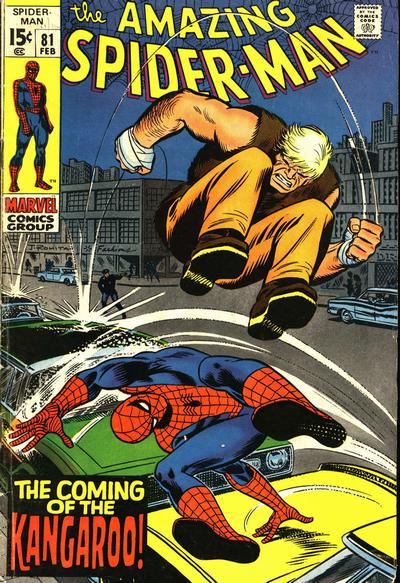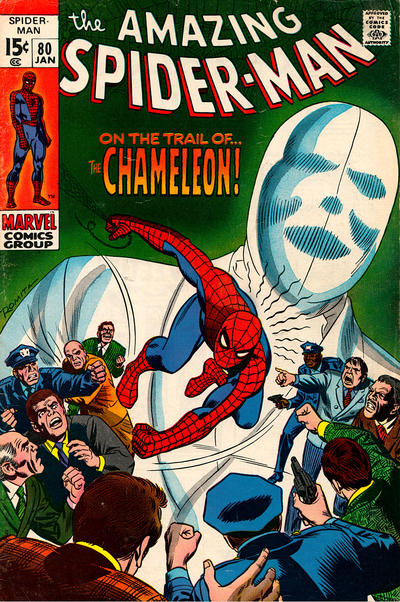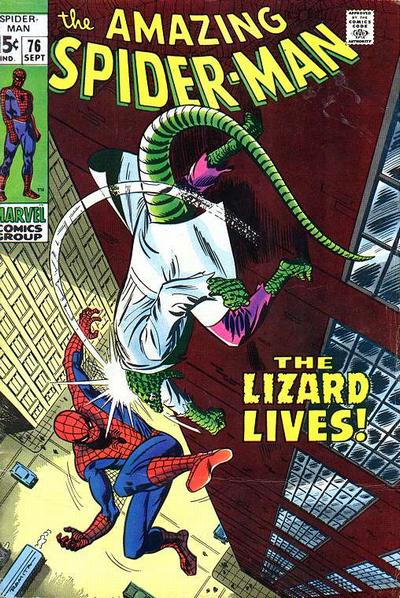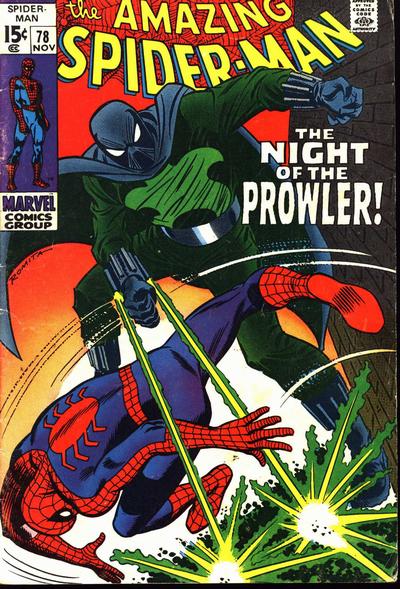The end of the ’60s was kind of an odd time for Your Friendly Neighborhood Spider-Man…

—
Welcome to The Spider’s Web — a new ongoing feature by novelist and Archie Comics Co-President Alex Segura that looks at Spider-Man’s development since his start in 1962’s Amazing Fantasy #15. (Alex has been re-reading from the beginning.) Each installment covers a specific period in Spidey’s history, with Alex giving you a kind of bouncing ball approach, as opposed to an issue-by-issue breakdown. Click here for the complete index of columns. — Dan
—
By ALEX SEGURA
Welcome back to my rambling, stream-of-consciousness riffing on Spider-Man.
We’re at about Issue #80 of Amazing Spider-Man, right around the time John Buscema and Jim Mooney would fill in for John Romita on interiors, and we’ve hit a, well, rough patch in terms of villains.
Though I love the Prowler, we get saddled with the Kangaroo — Stan Lee valiantly makes him seem more threatening because he’s holding onto a deadly virus (still — the Kangaroo?!) — and lose some steam coming out of the great Stone Tablet Saga.

Romita cover
There’s a fun Lizard story that doesn’t feel all that fleshed out — he has no real plan and Spidey stops him by tossing dehydrating powder on him. (Though the Human Torch cameo kind of saves it.)
Buscema is a master, so nothing is lost on the art side, though I did find myself missing John Romita’s pretty take on Gwen and the supporting cast. Harry’s Fu Manchu mustache makes a brief and forgettable appearance, too. And Gwen Stacy has to be the most patient girlfriend on the planet. Pete literally disappears FOR DAYS without even calling.
It’s interesting to see Stan dig back and bring some of the early villains into the book, like the Chameleon, whom we hadn’t seen since Kraven’s first appearance! Electro had also been gone a while, and while his return is pretty paint-by-numbers, the art and Jonah subplot make it work.

Romita cover
For me, it’s always the subplots that keep me coming back. If I’m exhausted, I find it much easier to skim the in-battle banter and spend more time with Pete’s personal struggles — short on cash, pining for Gwen, worrying about Aunt May. Even at this point, well past the initial Marvel revolution, it feels like Spider-Man was still leading the pack in terms of this kind of heavy, interpersonal drama, at least when it comes to solo superheroics.
As much as I love this run, you can tell Stan is losing a bit of juice — in a way that’s much less obvious on Fantastic Four (with Jack Kirby). Again, while these comics are fun and pretty much A-List superhero stuff, I think you start to see a bit of wear, Stone Tablet Saga aside: The dusting off of old villains (Electro, Shocker, an over-reliance on Kingpin, Mysterio) and the less-than-great new villains (Kangaroo), plus rehashed subplots (Aunt May is sick! Pete is broke! Is Gwen dating someone else?!) make the latter half of his run border on formulaic.

Romita cover
Still, Stan keeps it interesting — I thought Spidey’s fear of having murdered J. Jonah Jameson was super-compelling and emotional. Also really love how Stan maintains the everyman superhero aspect that I feel is sometimes lost — Spidey doing his laundry, having to wait for Harry to get to sleep to sneak into the apartment, etc.)
I say all this as a big fan of these comics. Quibbles, really. I’m having fun revisiting these.

Romita cover
Some quick thoughts:
— My first exposure to Silvermane was an old Web of Spider-Man issue drawn by Alex Saviuk (story by Terry Kavanagh), so when I eventually read his origin it made his journey from mob boss to cyborg mob boss feel pretty weird! Whatever happened to Big C Cicero?
— I kind of love the Schemer. Though Richard Fisk’s later alter ego, the Rose, is a pretty cool villain name, too.
— There should be a Prowler ongoing comic. Such a great character.
— LOL @ “Maggia” instead of Mafia.
— Next time, we hit the final stages of Stan’s run — and a hint of what’s to come. In the meantime, give us your thoughts and memories in the comments below or in whichever social-media thread you found this!
—
MORE From THE SPIDER’S WEB
— The Days of Ditko to the Reign of Romita. Click here.
— For the Complete THE SPIDER’S WEB Index of Features. Click here.

July 9, 2019
Alex, issue 81 came out sometime around my eleventh birthday and the Kangaroo was the final straw for me. In my previous comment I mentioned how I feel that issues 39-56 are the best run of comic books ever to see print. Well, the precipitous drop in quality in the two succeeding years was too much for me to handle and I stopped collecting ASM. Out of frustration, I sold my 48 issue collection, consisting of most issues dating back to #20 and all of the annuals, to a long forgotten friend for the princely sum of 5 bucks.
Even so, I did still have fond memories of those early Ditko and Romita issues and when the three pocket book collections that included AF 15 up to ASM 20 came out in the late 70s, I snapped them up and eagerly reread those stories. Flip ahead to the early 90s and I discovered the Marvel Masterworks books. Well, those beautiful books, combined with my four year old son’s love of super heroes, put me back in collecting mode and I purchased all of the different titles that I collected as a kid.
It didn’t take too long and I had every ASM story in some form or another, whether it was a reprint in a Marvel Masterworks book or Marvel Tales comic or a more recent original copy of ASM. Turn the clock ahead another 25 years and I now have a full collection of Vol. 1 ASMs except for #1 (I do have a CGC 9.0 copy of the 1966 Golden Record reprint) and AF 15. I treasure them all.
Before I go, I wanted to mention that I agree with you about the Roger Stern run. It was terrific and I regret not purchasing the omnibus which collected all of his ASM and SSM stories when it was still in print and more affordable.
July 9, 2019
Hey John! Yeah, there’s definitely a dip in terms of story and impact – the art remains beautiful, but I think you can see Stan spread too thin, and with Steve Ditko gone – the bulk of the story fell to him, and it shows. But still, an okay Lee/Romita comic is still pretty darn good!
July 9, 2019
One thing worth noting about this era is that it coincides with Marvel’s temporary turn (probably dictated by then-publisher Martin Goodman) towards non-continued stories. I think that policy change has a lot to do with the run of mostly forgettable “done-in-one” stories featuring the Kangaroo, the Chameleon, Electro, et al.
July 9, 2019
Possibly, and it does stand in contrast to a few earlier stories – the Green Goblin and Master Planner come to mind – that stretched for 2-3 issues.